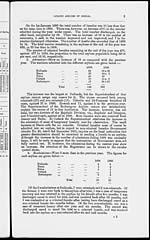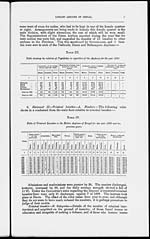Medicine - Mental health > 1867-1924 - Annual report of the insane asylums in Bengal > Lunatic asylums in Bengal annual reports 1899-1911 > Annual report on the lunatic asylums of Bengal for the year 1899
(14) Page 4
Download files
Individual page:
Thumbnail gallery: Grid view | List view

4 LUNATIC ASYLUMS OF BENGAL.
Of the four readmissions at Dacca, three were returned to the asylum after
trial and one was sent back from the jail after two weeks. He was sane in
the asylum for over four years, and relapsed into furious mania after a fort-
night's confinement in the jail. The lunatic has again recovered.
The case at Patna was a criminal sent back to the asylum after trial.
At Cuttack one female non-criminal was discharged, although not improved,
at the request of her relatives, but sent back after three months and 23 days,
as she became unmanageable.
As regards the three readmissions at Berhampore, two were returned to the
asylum after trial. The third was also a criminal, who improved and was
made over to his friends on security, but received back into the asylum after
three years.
5. Discharges—Numbered 155, against 99 in the previous year, distributed
as follows:—
|
1898. |
1899. |
|
|
Dullunda ... ... ... |
37 |
44 |
|
Dacca ... ... ... |
23 |
34 |
|
Patna ... ... ... |
19 |
28 |
|
Cuttack ... ... ... |
... |
9 |
|
Berhampore ... ... ... |
20 |
40 |
|
Total ... |
99 |
155 |
The increase was general. At Dullunda it is explained by the Superin-
tendent as being partly due to the fact that a larger number of cases found
sane on admission were either sent to stand their trial, or made over to their
relatives, and partly to greater efforts made to find out the friends of harm-
less lunatics and to induce them to take charge of them. The increase of
11 at Dacca was due to more recoveries, viz., 22 against 18, while 7 were
qualified for transfer to jail after recovery against nil in 1898. At Patna
9 criminals were sent to stand their trial, but not received back during the
year under review. At Cuttack there were 8 recoveries, against nil in the
previous year. At Berhampore the increase was also due to greater recover-
ies and to a larger number of improved cases having been made over to their
relatives.
6. Recoveries to strength.—The following table shows the proportion of
recoveries to daily average strength:—
TABLE II.
|
Daily average strength. |
Number of recoveries. |
Percentage of recoveries |
||||
|
1898. |
1899. |
1898. |
1899. |
1898. |
1899. |
|
|
1 |
2 |
3 |
4 |
5 |
6 |
|
|
Dullunda. ... ... |
218.34 |
215.01 |
25 |
25 |
11.45 |
11.62 |
|
Dacca ... ... |
226.54 |
219.72 |
18 |
29 |
7.94 |
13.19 |
|
Patna ... ... |
235.50 |
236.31 |
10 |
19 |
4.24 |
8.04 |
|
Cuttack ... ... |
38.84 |
42.95 |
...... |
8 |
...... |
18.62 |
|
Berhampore ... |
202.83 |
188.85 |
18 |
29 |
8.87 |
15.35 |
The percentage of recoveries at Dacca was higher than in any year since
1894. Twelve criminals recovered and were sent to stand their trial, against 4
in 1898. At Patna the proportion of lunatics recovered was also greater than in
1898. At Cuttack there were recoveries both among toxic and non-toxic cases.
The Superintendent of the Berhampore Asylum attributes the increase to the
cases admitted having been of a mild type.
7 Accommodation.—The following table shows that the accommodation
remained unchanged, and was sufficient in all the asylums except at Dacca,
where there was some overcrowding in the female division towards the
latter part of the year. This has since been relieved by the transfer of four
females to the Dullunda Lunatic Asylum. At Cuttack there was at one time
Set display mode to: Large image | Zoom image | Transcription
Images and transcriptions on this page, including medium image downloads, may be used under the Creative Commons Attribution 4.0 International Licence unless otherwise stated. ![]()
| Permanent URL | https://digital.nls.uk/83540193 |
|---|




